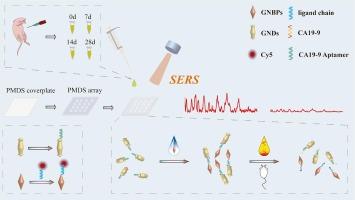基于表面增强拉曼光谱适配体传感器的碳水化合物抗原-19-9 早期检测技术
IF 4.9
2区 化学
Q1 CHEMISTRY, ANALYTICAL
引用次数: 0
摘要
背景宫颈癌的早期筛查对于治疗和改善预后至关重要。本研究开发了基于 SERS 的适配体传感器(aptasensor),并将其应用于宫颈癌肿瘤标志物(碳水化合物抗原 19-9 (CA19-9))的高灵敏度检测,其微孔芯片被用作表面增强拉曼散射(SERS)分析平台。方法将 CA19-9 的适配体固定在金纳米哑铃上作为捕获探针,将含有信号分子 Cy5 的互补适配体链的金纳米双锥体修饰成信号探针。通过信号探针和捕获探针的组合,构建了 SERS 准传感器。信号分子Cy5被夹在信号探针和捕获探针之间,构建的SERS适配传感器产生了强烈的Cy5 SERS信号。 基于适配体的强特异性,当CA19-9存在于检测环境中时,CA19-9适配体会与CA19-9发生特异性结合。结果在最佳检测条件下,计算出该适配体的检测限为 1.16 × 10-3 U/mL,定量限为 3.87 × 10-3 U/mL。此外,还构建了标准宫颈癌小鼠模型,并测定了不同阶段小鼠血清的 SERS 光谱。计算了不同阶段小鼠血清中 CA19-9 的含量。与酶联免疫吸附试验(ELISA)的结果相比,两种方法在0、7、14和28天检测到的CA19-9浓度的相对误差(RE)值分别为2.54%、-6.093%、-4.922%和3.04%。 结论:所提出的SERS灵敏传感器为早期宫颈癌筛查提供了一个新的、可靠的平台,其较低的RE值证明它将是一种有前途的CA19-9检测方法。本文章由计算机程序翻译,如有差异,请以英文原文为准。

Early detection for carbohydrate antigen-19-9 based on surface enhanced Raman spectroscopy aptamer sensor
Background
Incipient screening for cervical cancer is crucial for treatment and improving prognosis. In this work, SERS based aptamer sensor (aptasensor) has been developed and applied to high-sensitivity detection of cervical cancer tumor marker (Carbohydrate antigen19-9 (CA19-9)) with a microporous chip, which was used as surface enhanced Raman scattering (SERS) analysis platform.
Methods
The aptamer of CA19-9 was immobilized on the gold nanodumbbell as a capture probe and the gold nanobipyramid containing complementary aptamer chains of the signal molecule Cy5 was modified as a signal probe. SERS aptasensor was constructed by combining signal probes and capture probes. It caused signal molecule Cy5 were sandwiched between the signal probes and capture probes; the constructed SERS aptasensor generated a strong SERS signal of Cy5. Based on the strong specificity of the aptamer, the CA19-9 aptamer binds specifically to CA19-9 when CA19-9 exist in the detection environment. The signal probe was released, resulting in a decrease in the SERS signal of the detection environment.
Results
Under the optimal detection conditions, the detection limit of the aptasensor was calculated to be 1.16 × 10−3 U/mL and limit of quantification is equal to 3.87 × 10−3 U/mL. In addition, a standard cervical cancer bearing mouse model was constructed and the SERS spectra of the serum of mice at different stages were measured. The CA19-9 content in the serum of mice at different stages was calculated. Compared with the results of enzyme-linked immunosorbent assay (ELISA), relative error (RE) values (2.54 %, −6.093 %, −4.922 %, and 3.04 %) of the CA19-9 concentrations detected by the two methods on the day of 0, 7, 14 and 28.
Conclusion
The proposed SERS aptasensor provides a new and reliable platform for early cervical cancer screening, and its low RE value proves that it will be a promising CA19-9 detection method.
求助全文
通过发布文献求助,成功后即可免费获取论文全文。
去求助
来源期刊

Microchemical Journal
化学-分析化学
CiteScore
8.70
自引率
8.30%
发文量
1131
审稿时长
1.9 months
期刊介绍:
The Microchemical Journal is a peer reviewed journal devoted to all aspects and phases of analytical chemistry and chemical analysis. The Microchemical Journal publishes articles which are at the forefront of modern analytical chemistry and cover innovations in the techniques to the finest possible limits. This includes fundamental aspects, instrumentation, new developments, innovative and novel methods and applications including environmental and clinical field.
Traditional classical analytical methods such as spectrophotometry and titrimetry as well as established instrumentation methods such as flame and graphite furnace atomic absorption spectrometry, gas chromatography, and modified glassy or carbon electrode electrochemical methods will be considered, provided they show significant improvements and novelty compared to the established methods.
 求助内容:
求助内容: 应助结果提醒方式:
应助结果提醒方式:


